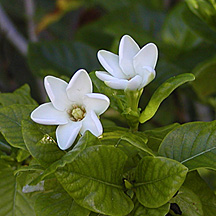|
In the Garden
|
Rare gardenia species is
on endangered list
Gardenia brighamii
Hawaiian gardenia
Description: This large shrub grows 4 to 20 feet tall, with light green leaves and a light tan trunk. Tiny clear to opaque yellow resin balls develop at its stem tips prior to the formation of new leaves. Flowers measuring about 2 inches across resemble a tuberose flower rather than a gardenia, and smell like the larger bushy, non-native gardenia flower with a hint of coconut oil. It smells so good that you might want to eat it, but I wouldn't recommend that; it tastes terrible. Once the flowers are pollinated, a large green fruit about the size of a golf ball forms. Inside the ripe fruit, brilliant yellow-orange pulp surrounds a hard seed capsule containing about 100 seeds.
 Distribution: This rare endemic plant is one of many native Hawaiian plants on the federal list of endangered species. About three plants remain in the wild on Oahu, one plant on the Big Island, a few on Molokai, a handful on Lanai and a few more on Maui, totaling 15 to 20 plants.
Distribution: This rare endemic plant is one of many native Hawaiian plants on the federal list of endangered species. About three plants remain in the wild on Oahu, one plant on the Big Island, a few on Molokai, a handful on Lanai and a few more on Maui, totaling 15 to 20 plants.
The Hawaiian gardenia was once believed to have existed on all of the main islands in the dry forest, but is now restricted to the populations mentioned above. The lowland dry forest, where this and many other native plants are found, is the most species-diverse ecotype in Hawaii. It is also the most threatened. Only 5 percent of it remains; 95 percent of the native lowland dry forest, including all plants and animals within it, are gone.
Cultural uses: The yellow-orange pulp found within the fruit was highly valued for making a rich yellow dye for royalty. The color is so unique that it was called na'u, after the plant from which it is derived. The light-colored wood was also used for making house posts for people of high status, and the fragrant flowers were strung into leis. Today, this would be the perfect flower to place behind the ear to highlight a women's beauty, and because of its fragrance.
Landscape use and care: This must-have plant looks great as a hedge (if enough are available) or as a specimen plant to stands alone in all its glory. Treat this plant like puakenikeni, that is, put it where everyone can see it. This plant deserves it!
Full sun is best for helping the plant grow faster, stay bushier and flower. Daily watering is fine if you have well-drained soil; if not, wait until the surrounding soil dries before watering again. Once the plant is established, reduce watering to once every two to four days or when needed. This plant doesn't require much watering, which is great for the summer, when water conservation is so important.
Also: There are two more species of gardenia that are native to Hawaii. Can you name them? No, not the tiare -- that comes from Tahiti -- and not the Amy.
The two other na'u are Gardenia manii, another endangered plant found only on Oahu, and Gardenia remyi, a rare plant not yet listed as endangered, found on Kauai, Maui, Molokai and Hawaii. So many Hawaiian plants were not available for purchase that gardeners were forced to buy non-natives like tiare or a Fijian fan palm instead of the native loulu. Now that many of these plants are available, it make sense to help perpetuate our unique Hawaiian species instead of plants that can potentially become invasive species.
![]()
E-mail to Features Desk
[News] [Business] [Features] [Sports] [Editorial] [Do It Electric!]
[Classified Ads] [Search] [Subscribe] [Info] [Letter to Editor]
[Feedback]
